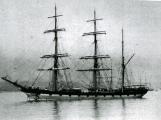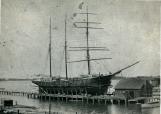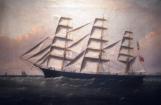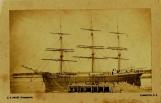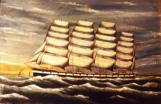29
The barque "Bowman B. Law"Ordered by William Law & Co. from builders in Dumbarton, Scotland, in 1885, the "Bowman B. Law" was Yarmouth's first iron vessel (and Canada's second iron square-rigger). The Yarmouth County Archives owns the 'Specification Book' for this vessel which gives an amazing amount of information about her construction and her initial outfit of supplies. The "Bowman B. Law" circled the world five times, carrying a variety of cargoes. The vessel was finally lost to fire at Tegal, Java, in October, 1901. This portrait photograph was taken in San Francisco by Mr. Wilton, marine photographer. The painted 'gunports' along the ship's side were, by the 1880's quite fashionable, and were not to fool pirates into thinking she was an armed vessel, as was the original intention of such a paint scheme. The "Bowman B. Law" was named after the owner's son who became a Member of Parliament for Yarmouth and was the only MP who died in the fire that destroyed the Parliament buildings in 1916.
31
Four-masted barque: a four masted vessel square rigged on all but the last (spanker) mast.The 4-masted barque "Levernbank" is shown here in an unsigned 'Chinese' ship portrait (attributed to Lai Fong, of Calcutta). Built in Port Glasgow, Scotland in 1893 by Russell & Co. for the Bank Line, the Levernbank was 282.9 feet in length, had a beam of 43 feet, a 24.4 foot depth of hold and was 2400 registered tons. The vessel was captained by Capt. Stephen Bent of Yarmouth and others. It was abandoned after being dismasted on a voyage from Bilbao, Spain for Cardiff, Wales with a cargo of iron ore on November 29th, 1909.
33
The barquentine "Sentinel".The "Sentinel" was a typical large barquentine of the 1890's. Built at Belliveau's Cove, N.S. in 1885 she belonged to the well-known shipowner W.D. Lovitt of Yarmouth. "Sentinel" was 500 tons and 148 feet in length. In this painting she is shown with all sails set including jibs, staysails and gaff topsails. This painting is signed 'J. Fannen / 1896'. Fannen was an artist who worked out of Sunderland on the North East coast of England.
35
The barquentine "Baldwin".In this photograph the "Baldwin" is shown on the Yarmouth Marine Railway slip. Built at Meteghan, Nova Scotia, in 1891 and owned in Yarmouth, the "Baldwin" (561 tons) was constructed specifically to carry locomotives to Argentina. Named for the Baldwin Locomotive Company of the United States, she carried two of their locomotives at a time in her hold. Being rigged as a barquentine, with less rigging than a barque or a full-rigged ship, was undoubtedly of considerable advantage when it came to loading and unloading such large and heavy cargoes. Other cargoes later carried by this vessel were mahogany wood for New York, coal for Yarmouth, lumber for Buenos Aires, linseed for Europe and salt from Turks Island.
37
Ship: a three masted vessel, square rigged on all three masts.The full-rigged ship "Euphemia" is portrayed with the after (back) portion of the sails showing - an unusual depiction of a vessel in a ship portrait. The "Euphemia" was owned in Yarmouth by Henry Lewis and others included Capt. Francis Cook, her first master, who named the vessel after his daughter Euphemia. Built at Salmon River, N.S. in 1882 the "Euphemia's" dimensions were: length 205 feet, breadth 39.6 feet, depth of hold 22.6 feet, gross tonnage was 1380 tons. She was sold to the British in 1899 and to Italian interests in 1900. Her final fate is not known. This portrait, by W. H. Yorke of Liverpool, England, has the vessel passing Point Lynas lighthouse on the north coast of Wales on her way into Liverpool. Oil on canvas painting, captioned '"Euphemia" 1367 tons of Yarmouth. N.S. Captn W.H. Cook.'
39
The ship "Lillie Soullard "Built in 1871 in Port Gilbert, Nova Scotia, the "Lillie Soullard" was named after the wife of a Savannah, Georgia, ship agent. After twenty years of good service to her Yarmouth owners the ship was sold to Saint John, N.B. interests for $4000 and was renamed "Lockwood". This photograph shows her secured to one of Yarmouth's many wharves. The crew, all facing the camera, were aware that this picture was being taken, as was the captain and his wife, sitting on the cabin top with their children or some female visitors.
41
Four-masted ship: a vessel with four masts, square rigged on all.The four-masted ship "Lancing" is shown in this unsigned, folk art-like, oil on canvas painting. The "Lancing" was had an unusual 'life' as she was built of iron in Glasgow, Scotland in 1866 as a steamer, the "Pereire", for French owners. Her dimensions were: 356' x 43.8' x 27.3', 2875 tons. She was converted to a sailing vessel with the unusual rig of a four-masted ship in 1888 by Capt. George Alfred Hatfield of Yarmouth County. His nephew, Capt S.J. Hatfield, then commanded her. In 1908 the "Lancing" sailed from Tusket Wedge (now Wedgeport, NS) with 2,272,000 superficial feet of lumber for cargo: the largest lumber cargo ever taken from Nova Scotia. She was later reconverted to a steamer. In 1924 the "Lancing" was broken up while under Norwegian ownership.
